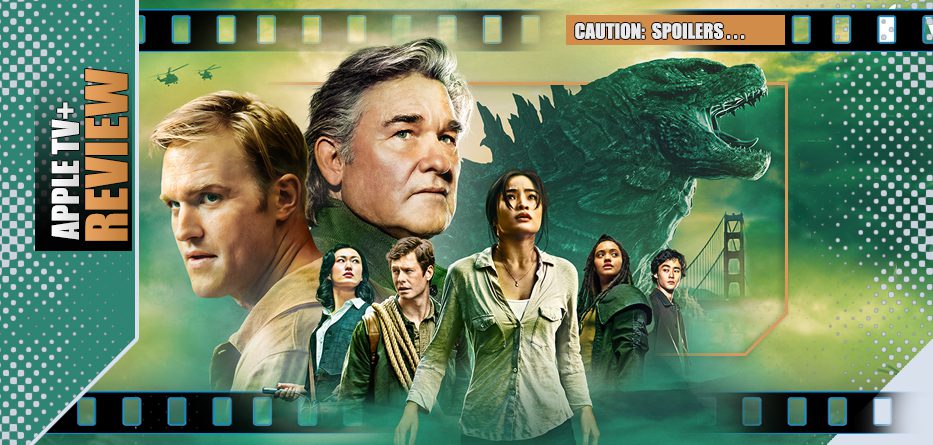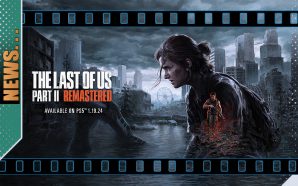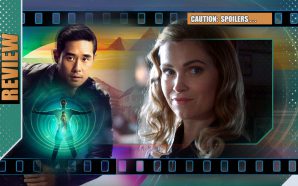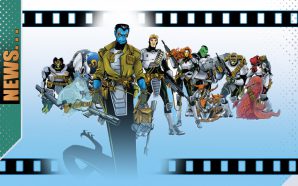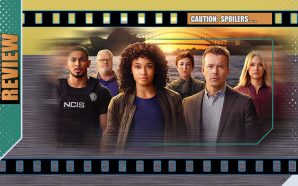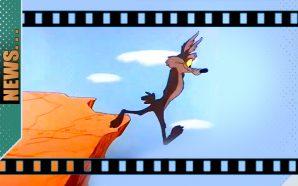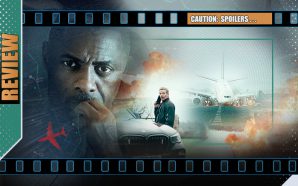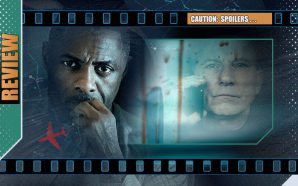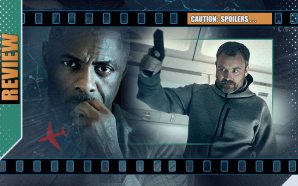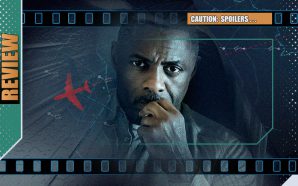In the aftermath of Godzilla’s 2014 arrival in San Francisco, Cate (Anna Sawai) journeys to Tokyo to find information on her missing father and is surprised to find that he left more than just secrets… he had an entirely different family. Tempted to flee back to the States, Cate discovers some strange secrets that make her and her newly discovered half-brother Kentaro (Ren Watabe) and his computer whiz friend May (Kiersey Clemons) begin to realise that their family may have had a far more central role in the monitoring of the Titans, or ‘kaiju’ than anyone could have guessed. And now someone is after them and they need help…
Those secrets stretch back decades and to the earliest days of the ‘Monarch organisation… where a young officer Lee Shaw (Wyatt Russell) is sent on a mission as an armed escort for Dr. Keiko Mira (Mari Yamamoto) and Dr. Bill Randa (Anders Holm) into the heart of potentially radioactive territory as they conduct their monster research with deadly results.
Many, many, years later, Cate, Kentaro and May are about to find out that Lee Shaw is still a force to be reckoned with…
*spoilers*
For a long time, the holy grail of mythological franchising was to have a simultaneous, cohesive film and television universe, a multimedia sense of world-building built with equal budgets, VFX and passion. Yes, Star Wars and Marvel have built their universes to varying degrees over the last decade, but looking across the landscape, there have been more failures than successes, more good intentions rather than results. A record number of millions were spent on last year’s spy-fi Citadel with the mission statement talking of multiple international branches would join together to make it a Mission Impossible for the streaming generation, but it’s all gone rather quiet since. Budgets and brand loyalty have been the third-rails of such attempts. Many productions require not just genuine ambition but pragmatic financing way ahead of knowing whether an audience is guaranteed and even then, will it all knit together as well as intended?
Monarch: Legacy of Monsters is an interesting addition to the attempt and you have to admire that ambition from the outset: taking one of the most classic ‘monsters’ of the last century of film-making and weaving in various aspects of that mythology – making the most recent movie entries canon (at least in this universe) and expanding that continuity backwards and forwards across two different time periods and out into a tv series that seeks to explore it all on a generational level.
Can audiences come in cold to Monarch? The answer is mixed… and initially, no. It really helps if you’ve seen Godzilla, Kong: Skull Island and Godzilla vs. Kong. It’s going to take some patience and perseverance to fully understand the motivations and history of various key characters and their connections to other off-screen characters in a world where key events and tone were established by those cinematic releases. Though we quickly see the way that the existence of the monsters (such as Godzilla and Kong) and their emergence and disappearance have changed the way people live in almost-contemporary times (Tokyo has emergency shelters in case of more attacks and there’s a global sense of unease hammocked between some thinking ‘it was all CGI fakery’ and genuine PTSD from people who were there), a lot of the specifics of the necessary world-building has gone before and if you haven’t seen those films, you’ll be playing catch-up to the kaiju and the momentum of the ‘muto’ (massive unidentified terrestrial organisms).
…a production that treats its audience as intelligent and makes them concentrate in an effort to keep up. It knows you may have tuned in for the widescreen monsters but it’s going to make you stick around for wholesale answers…
However, smartly, it does provide the framework to do so: Story-telling-wise there’s an almost Watchmen approach to the construction of the story, flitting backwards and forwards and not always giving you specific context until later. For instance, the first meeting of Wyatt Russell’s Lee Shaw and Mari Yamamoto’s Dr. Keiko Miura isn’t shown until the start of the second episode, though much of the first shows them later down the timeline accompanied by Anders Holm’s Bill Randa (crypto-zoologist , later her romantic partner and even later John Goodman’s older version from the films, here only seen briefly – again, it pays to have been along for the previous cinematic ride). Arguably, the first two episodes leave the same characters in similar predicaments at different points in the timeline. But this is also a production that treats its audience as intelligent and makes them concentrate in an effort to keep up. It knows you may have tuned in for the widescreen monsters but it’s going to make you stick around for wholesale answers. Subsequently, there’s some good character development and discussion of the two-way prejudices that existed (and perhaps still exist) in the wake of World War II and the various agendas involved.
One of the other attractions of the series is seeing Kurt Russell and son Wyatt Russell playing the same character – full name Leland LaFayette Shaw III – at different points in their lives (though the elder veteran doesn’t show up until the end of the second episode). A quick mental calculation suggests that the elder Shaw must be in his 90s during the 2010s and even though Kurt Russell is now an elder statesman, he’s a good twenty years younger and it shows. However, both generations show similar levels of charisma and it makes it easy to believe they are the same person. The international cast helps afform both western and eastern cultures, which are shown with brickbats and bouquets, praise and criticism.
The appletv+ series gives audiences two episodes to get into the story, which it needs to establish tone and pace. In its effort to tell that generational story – and the development of the Monarch initiative – the series makes character as important as spectacle, a potentially risky move that pays off due to the balance of slow burn story and the set-piece scale. Some characters fare better than others in the early episodes, but there’s a growing investment in the main protagonists and their efforts to get answers. Of course, as expected, it delivers on the VFX-front. Hardcore Godzilla fans might be disappointed by the minimal use of their city-stomping favourite, but it’s far better than over-use and it saves its biggest reaches for key scenes, instead using strong production design to place a majority of scenes in urban metropolis alleyways or wide-open spaces. But the flashback to G-Day and Godzilla’s rampage through San Francisco and giant creepy insectoid creatures scurrying around a fallen nuclear reactor are effective as is the tension it builds before and during.
You’ll arrive for the monsters and stay for the world-building. To tweak and reverse a line I used when reviewing the somewhat ill-fated 1997 Godzilla film, we are promised a croc of epic proportions, but Monarch: Legacy of Monsters avoids the potential for being an expensive crock of something else entirely. The first two episodes are an impressive mission statement, a clear indication that televisual storytelling has emerged into a more assured and creative era in the last decade and this shows every sign of netting more than the expected Godzilla fans, attracting fans of world-building with a dash of collateral damaged derring-do…

- Story9
- Acting9
- Directing9
- Production Design / VFX10

